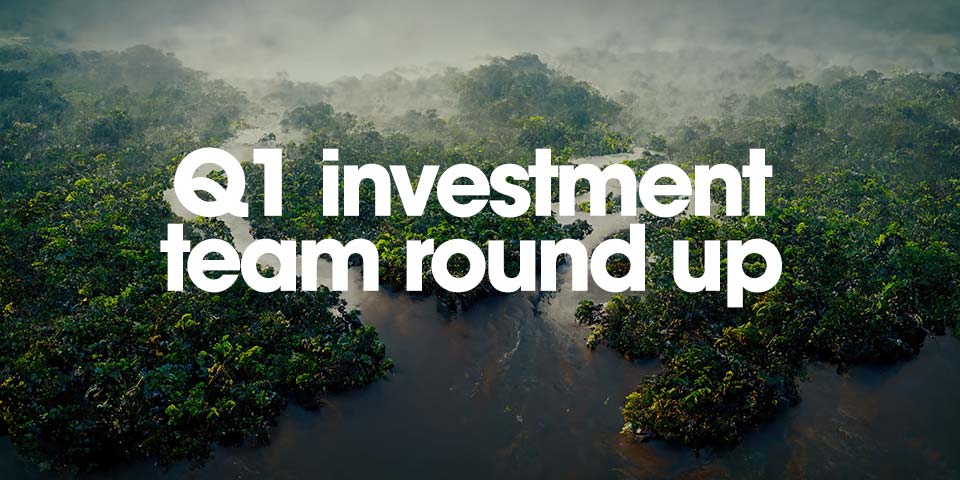The Holden & Partners’ Q1 investment team round up

As tumultuous financial times have followed us into 2023, our inhouse investment team at Holden & Partners plays a crucial role in monitoring the economic environment and informing our decision making. Here Investment Director, Paul Dennis and his team take us through the first three months of the year.
Included in this update
UK – We witnessed a mixed start to the year and important developments around nuclear energy.
Europe – There are signs that the effects of the war on European inflation could be starting to moderate.
Asia – Asian equities briefly continued their resurgence following the end of China’s zero COVID policy, with a partial reversal following an increase in geopolitical tension.
US – The collapse of Silicon Valley Bank in March was a traumatic ending to what had been a relatively calm and positive start to the year.
Alternatives – Real estate was under the spotlight in Q1 as the effects of most global central banks’ tight monetary policy filtered their way through the global economy.
Banking Problems – SVB and Credit Suisse: what happened and what next?
Our portfolios – Explaining some of our portfolio decisions and how they have fared.
UK

The FTSE 100 closed at an all-time high mid-February, before falling sharply in March, erasing year-to-date gains and ending the rally that began in October 2022. The collapse of Silicon Valley Bank and the forced merger of Credit Suisse and UBS sent tremors across the global banking system. Despite systemic risk being low due to the stringent regulatory oversight of UK banks, FTSE financial stocks fell sharply, wiping out strong gains from the beginning of the year as investors on the back of rising interest rates. Declining oil and industrial metal prices weighed on commodity giants, before a broad recovery in the last days of March led to positive returns over the quarter (3.6%), yet lagged developed peers. 1 UK government and investment grade bonds finished the quarter on par with each other (2.4%) as a flight to safety saw government bonds rally in March. 2
The Bank of England (BoE) raised rates from 3.5% at the start of 2023 to 4.25%, with neither of the two rate increases coming as a surprise to market participants. An above estimate February CPI inflation figure rocked the consensus expectation of steady disinflation and potential interest rate peaks. Accelerating core inflation is a problem for Central Banks when the traditional remedy inflicts greater pain on consumers, with signs of economic stress evident in falling house prices and real incomes.
Jeremy Hunt refused calls from fellow Tory MPs by pressing ahead with the corporation tax increase in the Spring Budget. Other measures sought to drive domestic investment, such as the investment zones and capital expenditure support. Issues surrounding the UK’s capital market infrastructure were once again highlighted when Arm Ltd, the British chip designer based in Cambridge, opted against a UK IPO in favour of a US listing, despite Rishi Sunak’s efforts to convince the chip designer to list on the LSE.
The UK now classes nuclear energy as environmentally sustainable in the green taxonomy, with a new programme aimed at generating 25% of the UK’s electricity by 2050 and providing a future pathway to pivot away from fossil fuels and support cyclical weather dependant renewable energy sources. 3
Europe

There was a touch of optimism in the air at the start of the quarter as strong Purchasing Managers Index (PMI) surveys, which measure services and manufacturing activity based on a monthly survey of purchasing managers, and German sentiment pointed to a resilient start to the year. Improvements in the PMI were broad-based as both manufacturing and services PMIs ticked up. January’s composite PMI jumped above the 50 level, which indicates growth in the business economy while the number for February reached a nine-month high of 52.3, buoyed by a mild winter, a brighter economic outlook, and easing uncertainty in areas like geopolitics and inflation. Despite inflation easing from 9.2% to 6.9% over the quarter, driven primarily by energy deflation, evidence of stickiness in core inflation (ex-energy and food) has emerged causing concern for the European Central Bank (ECB).
Moreover, the labour market remained hot, causing more headaches for the ECB. The latest employment data released in March showed labour demand remained largely unchanged in February as the unemployment rate remained at a low of 6.6% with another month of job gains.4 The sticky core inflation and tight labour market suggest the ECB will continue its hiking cycle, most likely raising interest rates by 0.25% in May and June.
24th February marked one year since Russia’s barbaric invasion of Ukraine. The war triggered a massive shock to the global economy, especially to energy and food markets, causing inflation pressures to increase. Looking ahead, there are signs that the effects of the war on European inflation could moderate, especially when one considers the annual pace of energy price growth has turned negative for the first time in years at -0.9% year-on-year.5 Unfortunately, however, the absence of a conclusion in the Russia-Ukraine war continues to push food inflation higher, with the latest reading for March showing a 15.4% increase year-on-year.6
Asia

Asian equities briefly continued their resurgence following the end of China’s zero COVID policy last year, recording strong gains in January. February saw a partial reversal following an increase in geopolitical tension, and fears of global demand faltering as the Fed marched forward in their campaign to fight inflation. Leading the losses in February was Indian conglomerate Adani Group, previously the largest conglomerate in the world’s fifth largest economy, after charges of severe misgovernance and fraud by US short-seller Hindenburg Research. The stock plunged 54% over the quarter to all-time lows, losing a staggering $108bn in the days following the short-seller’s allegations.7 Broader Indian equities suffered and underperformed the Emerging Market index due to increasing fears of deep-rooted governance issues given the close ties of founder Gautam Adani and Indian Prime Minister Narendra Modi.
In a similar fashion to developed markets, March saw high volatility followed by a broad recovery across equity markets, resulting in positive index returns for MSCI Asia Pacific ex-Japan (4.3%) and MSCI Emerging Markets (4%).8 Lower than expected inflation allowed the People’s Bank of China to maintain accommodative monetary policies, and strengthening economic data spurred optimism of growth fuelled by domestic consumption amid increased risks of recession in global trading partners.
After narrowly avoiding a recession in 2022, Japanese equities (6.2%) outperformed broader Asian equities over the first quarter of 2023.9 Yen weakness and Chinese economic strength buoyed sentiment for Japanese exporters, although geopolitical tensions arose towards the end of the month over Japanese export restrictions. Inflation slowed significantly in March, the first time in over a year, although this was skewed by government subsidies that depressed energy prices. For decades, the Bank of Japan (BoJ) has remained committed to ultra-loose monetary policy, but now with a leadership change imminent the nation finds itself with inflation above Central Bank targets and consistent falling real wages. Despite implying a continuation of monetary easing and accommodative monetary policy in the near term, BoJ governor nominee Kazuo Ueda called for creative monetary policy in the future to achieve sustainable target rate inflation.10
US

Following a relatively calm and positive start to the year, all eyes turned to the Fed for their March decision off the back of bank failures and general panic. With inflation persisting, labour markets remaining resilient, and economic activity proving strong, it looked unlikely that that we would see cuts to interest rates in 2023. The collapse of SVB and risk of contagion in the regional banking space, however, provided the Fed with plenty to think about. The volatility seen in treasury yields highlighted the level of fear following these events. The one-day drop in the 2-year yields was the biggest since the early 80s.11
There was a unanimous decision to raise the federal funds rate by 0.25%, bringing the range to 4.75%-5%, however, a pause in the rate rises was considered. Chair Powell’s press conference that followed stated that the direction of travel for rates was little changed from previous projections, however the events in the banking system are likely to result in tighter credit conditions for households and businesses, thus potentially offsetting the need for rate increases.12
Despite all the above, the S&P performed strongly over the quarter, rising by 4.58%.13 However, this was partly due to a rally in the tech stocks that dominate the market cap-weighted index, perhaps giving a false impression of health in the economy. Investors may be seeking safety in mega-cap companies while they weather the storm.
Alternatives

Real estate, more specifically US commercial real estate, was under the spotlight in Q1 as the effects of most global central banks’ tight monetary policy filtered their way through the global economy. As well as the enormous rise in interest rates for developers that are due for refinancing, the commercial real estate sector has been hit with low occupancy in offices and rising costs due to inflation. Moreover, regional banks account for most commercial real estate loans, making them vulnerable to a solvency crisis when these loans go bad. As a result, the CMBX Index which tracks a basket of 25 commercial mortgage-backed securities was down approximately 30% at one point in March. Moreover, European real estate equities have been hammered, with the MSCI Europe Real Estate index falling to its lowest level since early 2009 following a 24% decline in March.14
The regional banking crisis in the US and the collapse of Credit Suisse heightened the global recession risk, inflicting pain across the broad commodity sector with the Bloomberg Commodity Index falling approximately 6% in the quarter. The fall was driven by losses in energy, led by Brent crude oil which finished the quarter down 7% and at one point in mid-March fell below $75 a barrel for the first time since late 2021, and natural gas prices which finished the quarter down 48%. Losses in the index however were partly offset by gains in metals and not least precious metals, particularly gold, which finished the quarter up 7% to settle at $1,987 per ounce.
Banking Problems (SVB/Credit Suisse)

As we touched on earlier, there has been a lot in the press on the banking system and we wanted to provide a couple of comments.
What was the problem?
- SVB’s depositor base was very undiversified, with most deposits coming from early-stage companies.
– A large chunk of these deposits exceeded the FDIC limit of $250,000 (US’s equivalent to UK’s FSCS). - This was paired with an asset base that was very undiversified, holding long-dated treasuries which are more sensitive to interest rate increases, and their market value had dropped significantly as a result.
- To cover withdrawals the bank had to sell these assets at depressed market prices, causing concern amongst the depositor base. A rapid bank run followed as depositors moved their funds elsewhere.
How did the Fed respond?
- The Fed/FDIC announced they would protect all depositors (anything above the limit of $250,000), reducing panic and movements of deposits.
- The Fed introduced a new Bank Term Funding Program (BTFP), which is a much more generous program than previous lending facilities. It allows eligible institutions to borrow against eligible collaterals. The valuation of these collaterals/loans is based on the par value of the security as opposed to the market value, meaning banks will be able to avoid selling their collateral at depressed prices.
What happens now?
- These issues look to be contained within the regional banking sector, and we may see a longer-term consolidation to larger banks.
- We may also see increased regulation for smaller banks and a tightening in lending standards.
In Europe, we see UBS acquire Credit Suisse with the influence of the regulator. This was not because of the issues seen in the US, but a separate incident. The problems with the Swiss bank have been known for a while and have been clearly reflected in the deteriorating share price. An area of controversy arose when $17bn of Credit Suisse’s AT1 bonds were wiped out, having initially been expected to rank above shareholders. These riskier, higher yielding bonds are what are known as contingent convertibles (CoCos), coming with the feature that they convert into equity once certain capital limits have been breached.
While it’s hard to predict if we are likely to see contagion in the European banking space, it’s worth noting that they have much more liquidity vs, 2008, and face tighter regulation than their US counterparts. We may, however, see some retrenchment as banks fall back to home/core markets.
How the portfolios fared.

After what was one of the toughest years for returns in 2022, Q1 has provided some respite for our portfolios. As it stands at the end of the quarter our portfolios are showing positive returns ranging from 1.14% to 2.94%.
Whilst the returns have been pleasing, we remain cautious for the rest of the year. When investing what you don’t own is as important as what you do own. At the beginning of the year, we made changes to our portfolios to make them more defensive as we were concerned about the economic environment and the prospects of a recession. One decision was to sell our property exposure. Since selling, the property fund we held is down a further 12.5% with the expectation that it will suffer further as me move into a recessionary environment.
1. Morningstar FTSE 100 TR GBP Market Return 01/01/2023 – 31/03/2023: 3.55%
2. Morningstar Markit iBoxx GBP Gilt TR 01/01/2023 – 31/03/2023: 2.38%
Morningstar Markit iBoxx GBP NonGilts TR Market Return 01/01/2023 – 31/03/2023: 2.38%
3. https://www.gov.uk/government/news/nuclear-energy-what-you-need-to-know
6. Eurozone inflation drops as expected but core continues to rise | Snap | ING Think
8. Morningstar MSCI EM NR USD Market Return 01/01/2023 – 31/03/2023: 3.96%
Morningstar MSCI AC Asia Ex Japan NR USD 01/01/2023 – 31/03/2023: 4.34%
9. Morningstar MSCI Japan NR USD 01/01/2023 – 31/03/2023: 6.19%
10. https://www.ft.com/content/daa2b9b1-450e-4851-a632-0fc47777a99d
12. https://www.federalreserve.gov/mediacenter/files/FOMCpresconf20230322.pdf
13. GBP – Total Return – https://www.spglobal.com/spdji/en/indices/equity/sp-500/#overview
14. https://www.ft.com/content/85d18de2-2d69-487d-8718-a8f12ba47b49


